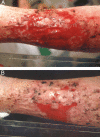Topical application of the tumour necrosis factor-alpha antibody infliximab improves healing of chronic wounds
- PMID: 16984574
- PMCID: PMC7951247
- DOI: 10.1111/j.1742-481X.2006.00233.x
Topical application of the tumour necrosis factor-alpha antibody infliximab improves healing of chronic wounds
Abstract
The role of tumour necrosis factor-alpha (TNF-alpha) in wound healing is not clear. Elevated levels of TNF-alpha have been observed in fluids from chronic wounds and have been shown to decrease over time during the healing process. Therapeutic antibodies such as infliximab can inhibit TNF-alpha activity. In this case series, we applied infliximab topically to eight patients with chronic ulcers of more than 4-month durations. The ulcers had multifactorial aetiology, with chronic venous insufficiency being the most prominent factor. All the ulcers had failed to respond to any previous conventional treatment. Infliximab was applied repeatedly to ulcers either as a 10 mg/ml solution and covered with an adhesive sheet or as a gel formulation (0.45, 1, or 4.5 mg/g) under a hydrofiber dressing/adhesive sheet. Improvement was assessed by measuring the percentage of change in the ulcer surface area. Seven of the eight patients (12 of 14 ulcers) responded to treatment with infliximab. After 4 weeks of treatment, surface area was reduced by more than 50% in 6 of the 14 treated ulcers. Within 8 weeks, five ulcers completely healed, while another four were reduced by more than 75% in size. Chronic, therapy-resistant leg ulcers responded well to repeated topical administration of a solution or a gel containing the TNF-alpha antibody, infliximab. Randomised controlled studies should be conducted to further evaluate the effect of topical infliximab on chronic wound healing.
Figures



Similar articles
-
Topical phenytoin versus EUSOL in the treatment of non-malignant chronic leg ulcers.East Afr Med J. 2003 Mar;80(3):124-9. doi: 10.4314/eamj.v80i3.8680. East Afr Med J. 2003. PMID: 12762426 Clinical Trial.
-
Topical timolol promotes healing of chronic leg ulcer.J Vasc Surg Venous Lymphat Disord. 2017 Nov;5(6):844-850. doi: 10.1016/j.jvsv.2017.04.019. Epub 2017 Aug 7. J Vasc Surg Venous Lymphat Disord. 2017. PMID: 29037357
-
Studies on zinc in wound healing.Acta Derm Venereol Suppl (Stockh). 1990;154:1-36. Acta Derm Venereol Suppl (Stockh). 1990. PMID: 2275309 Clinical Trial.
-
Refractory ulcers: the role of tumor necrosis factor-alpha.J Am Acad Dermatol. 2010 Jul;63(1):146-54. doi: 10.1016/j.jaad.2009.08.004. J Am Acad Dermatol. 2010. PMID: 20542177 Review. No abstract available.
-
Factor XIII in ulcerative leg disease: background and preliminary clinical results.Semin Thromb Hemost. 1996;22(5):445-50. doi: 10.1055/s-2007-999044. Semin Thromb Hemost. 1996. PMID: 8989829 Review.
Cited by
-
Adalimumab treatment leads to reduction of tissue tumor necrosis factor-alpha correlated with venous leg ulcer improvement: a pilot study.Int Wound J. 2016 Oct;13(5):963-6. doi: 10.1111/iwj.12497. Epub 2015 Sep 24. Int Wound J. 2016. PMID: 26399369 Free PMC article. Clinical Trial.
-
Cytokine binding by polysaccharide-antibody conjugates.Mol Pharm. 2010 Oct 4;7(5):1769-77. doi: 10.1021/mp100150z. Epub 2010 Sep 1. Mol Pharm. 2010. PMID: 20726535 Free PMC article.
-
Anorectal stenosis after treatment with tumor necrosis factor alpha antibodies: a case series.J Med Case Rep. 2010 Jul 26;4:226. doi: 10.1186/1752-1947-4-226. J Med Case Rep. 2010. PMID: 20659338 Free PMC article.
-
Adalimumab plus topical tacrolimus for the treatment of pyoderma gangrenosum: Report of a case.Int Wound J. 2019 Aug;16(4):1047-1048. doi: 10.1111/iwj.13123. Epub 2019 Apr 1. Int Wound J. 2019. PMID: 30938050 Free PMC article. No abstract available.
-
PKCζ as a promising therapeutic target for TNFα-induced inflammatory disorders in chronic cutaneous wounds.Int J Mol Med. 2017 Nov;40(5):1335-1346. doi: 10.3892/ijmm.2017.3144. Epub 2017 Sep 20. Int J Mol Med. 2017. PMID: 28949382 Free PMC article.
References
-
- Singer A, Clark R. Cutaneous wound healing. N Engl J Med 1999;341:738–46. - PubMed
-
- Gillitzer R. Modernes Wundmanagement. Hautarzt 2002;53:130–47. - PubMed
-
- Dissemond J, Witthoff M, Brauns T, Haberer D, Goos M. pH values in chronic wounds, evaluation during modern wound treatement. Hautarzt 2003;54:959–65. - PubMed
-
- Tarnuzzer R, Schultz G. Biochemical analysis of acute and chronic wound environments. Wound Repair Regen 1996;4:321–5. - PubMed
-
- Ito A, Sato T, Iga T, Mori Y. Tumor necrosis factor bifunctionally regulates matrix metalloproteinases and tissue inhibitor of metalloproteinases (TIMP) production by human fibroblasts. FEBS Lett 1990;269:93–5. - PubMed
Publication types
MeSH terms
Substances
LinkOut - more resources
Full Text Sources
Other Literature Sources
Medical

